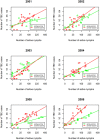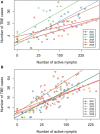Increased Relative Risk of Tick-Borne Encephalitis in Warmer Weather
- PMID: 29623261
- PMCID: PMC5874492
- DOI: 10.3389/fcimb.2018.00090
Increased Relative Risk of Tick-Borne Encephalitis in Warmer Weather
Abstract
Tick-borne encephalitis (TBE) is a serious acute neuroinfection of humans caused by a tick-borne flavivirus. The disease is typically seasonal, linked to the host-seeking activity of Ixodes ricinus (predominantly nymphs), the principal European tick vector species. To address the need for accurate risk predictions of contracting TBE, data on 4,044 TBE cases reported in the Czech Republic during 2001-2006 were compared with questing activity of I. ricinus nymphs monitored weekly at a defined location for the same 6-year period. A time shift of 21 days between infected tick bite and recorded disease onset provided the optimal model for comparing the number of cases of TBE with numbers of questing nymphs. Mean annual distribution of TBE cases and tick counts showed a similar bimodal distribution. Significantly, the ratio of TBE cases to questing nymphs was highest in the summer-autumn period even though the number of questing nymphs peaked in the spring-summer period. However, this pattern changed during a period of extreme meteorological events of flooding and abnormally high temperatures, indicating that changes in climate affect the incidence of TBE. Previous studies failed to link human behavior with changes in incidence of TBE but showed extrinsic temperature impacts arbovirus replication. Hence, we hypothesize the apparent discrepancy between peak nymphal tick activity and greatest risk of contracting TBE is due to the effect of temperature on virus replication in the tick vector. Relative proportions of questing nymphs and the numbers of weeks in which they were found were greater in summer-autumn compared with spring-summer at near-ground temperatures >5°C and at standard day and weekly average temperatures of >15°C. Thus, during the summer-autumn period, the virus dose in infected tick bites is likely greater owing to increased virus replication at higher microclimatic temperatures, consequently increasing the relative risk of contracting TBE per summer-autumn tick bite. The data support the use of weather-based forecasts of tick attack risk (based on daytime ambient temperature) supplemented with weekly average temperature (as a proxy for virus replication) to provide much-needed real-time forecasts of TBE risk.
Keywords: Ixodes ricinus; TBEV; arbovirus; climate change; seasonality; tick-borne encephalitis.
Figures








References
-
- Brabec M., Daniel M., Malý M., Danielová V., Kříž B., Kott I., et al. (2017). Analysis of meterological effects on the incidence of tick-borne encephalitis in the Czech Republic over a thirty-year period. Virol. Res. Rev. 1, 2–8. 10.15761/VRR.1000103 - DOI
-
- Daniel M., Beneš Č., Danielová V., Kříž B. (2011). Sixty years of research of tick-borne encephalitis – a basis of the current knowledge of the epidemiological situation in Central Europe. Epidemiol. Mikrobiol. Immunol. 60, 135–155. - PubMed
Publication types
MeSH terms
LinkOut - more resources
Full Text Sources
Other Literature Sources

